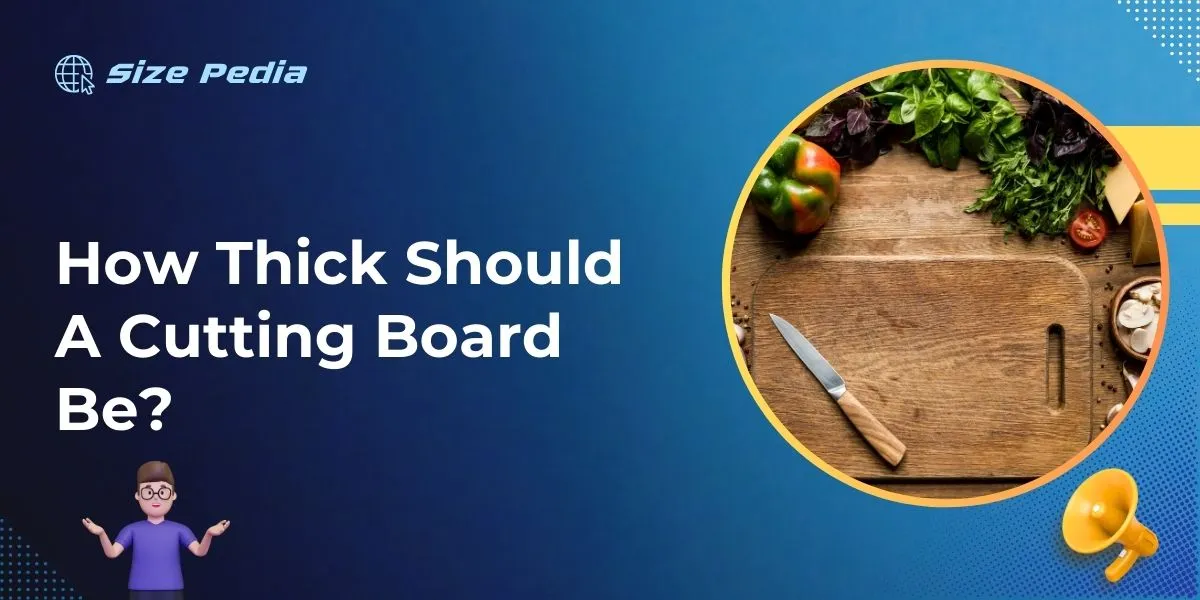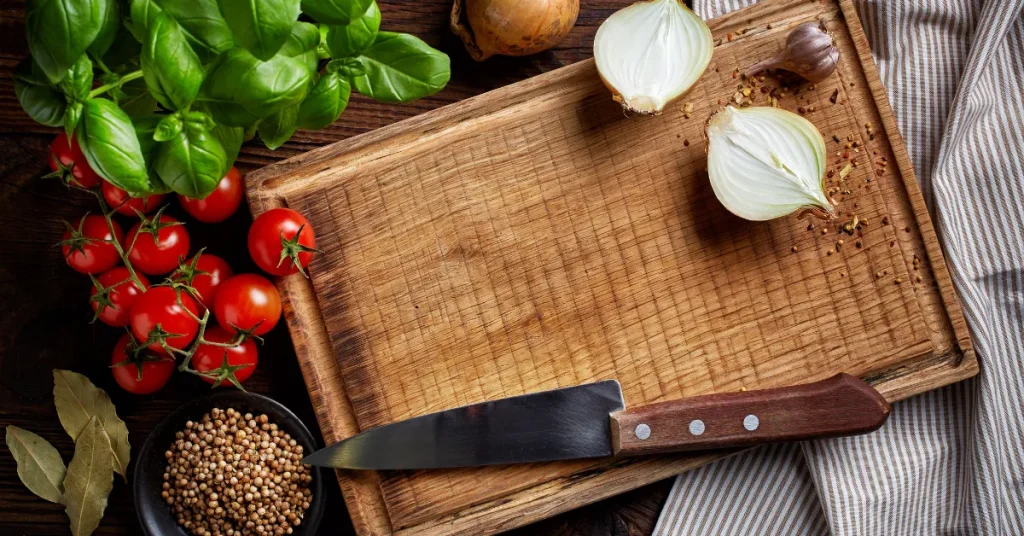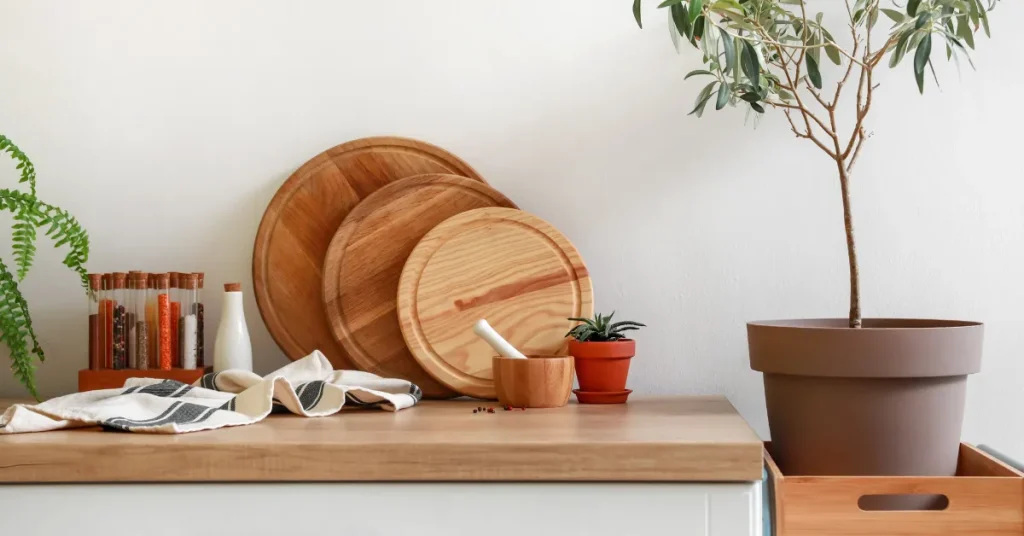A cutting board should be at least 1.5 inches thick to ensure durability and stability. Too thin boards can warp or crack under pressure.
Selecting the ideal cutting board is essential for both amateur cooks and professional chefs alike.
The thickness of the board plays a crucial role in its performance and longevity. A board that is sufficiently thick minimizes wear on knives, provides a stable cutting surface, and helps prevent the board from moving during use.
Opting for a cutting board of appropriate thickness also reduces the likelihood of the board warping over time, which can occur with thinner boards, especially when they are exposed to moisture.
It is a subtle yet fundamental aspect of kitchen equipment that affects safety, functionality, and the overall cooking experience.
Choosing a cutting board with the right thickness ensures that food preparation is both safe and enjoyable, making this simple piece of kitchenware an investment in your culinary adventures.

Importance Of Cutting Board Thickness
The thickness of a cutting board is a key factor in its overall usability and longevity. A well-chosen thickness ensures a durable, stable, and knife-friendly cutting surface.
Understanding the importance of this aspect can make all the difference in your cooking experience and tool maintenance.
Influence On Knife Edge Retention
A thicker cutting board can be gentler on knives, prolonging the sharpness of the blades. Cutting on surfaces that are too hard or too thin may cause knives to dull quickly.
Ideal cutting board thickness typically ranges between 1.5 to 2 inches, offering a soft bed that minimizes blade dulling.
- Prevents blade damage: Thick boards absorb cuts and help maintain knife edge.
- Reduces sharpening frequency: Less dulling equates to fewer sharpening sessions.
- Better for premium knives: High-quality blades stay sharp longer with the right board.
Impact On Stability During Use
A solid cutting board is vital for safety and precision. Heavier, thicker boards won’t slip or slide as you chop, which is crucial for consistent cuts. This stability also prevents accidents that could occur with unstable, thinner boards.
| Thickness | Stability Level |
| Less than 1 inch | Prone to sliding, less stable |
| 1.5 to 2 inches | Increased stability, no sliding |
| More than 2 inches | Optimal stability, heavy-duty |
Adequate thickness also ensures durability, with thicker boards able to withstand heavy chopping and cutting without splitting or warping.
For these reasons, professionals often favor boards that are thick enough to provide both knife edge retention and stability during use.
Materials Matter
When choosing a cutting board, the material is as vital as the design. A board’s thickness affects its durability and function. Today, we delve into different materials and how they determine the ideal thickness of cutting boards.
Wooden Board Density And Thickness
Wooden cutting boards are a top pick for many. They bring a classic look and solid feel to any kitchen. Dense woods like maple or walnut are long-lasting choices. Let’s consider the right thickness for these materials.
- Thinner boards (around 0.75 inches) are more lightweight and manageable, but may not withstand heavy chopping.
- Thicker boards, such as those up to 2 inches, provide sturdy surfaces and better absorb shock from knives.
To balance durability and ease of use, aim for a thickness of 1 to 1.5 inches.
Plastic And Composite Considerations
Plastic and composite cutting boards offer a modern alternative. They are easy to clean and gentle on knives.
| Material | Min Thickness | Max Thickness | Best For |
| Plastic | 0.25 inches | 1 inch | Everyday use, easy storage |
| Composite | 0.5 inches | 1.5 inches | Heavy-duty use, lasts longer |
Choose a plastic board for quick tasks and easy mobility around the kitchen. For those who need more resilience, composite boards are the smarter pick.
Thickness Recommendations For Different Uses

Choosing the right cutting board thickness can make a world of difference. Thicker boards tend to be more durable and steady, while thinner ones are easier to store and handle. Let’s explore which thickness is best for varying cooking needs.
Everyday Kitchen Tasks
Home chefs need a cutting board that is versatile and easy to maneuver. Consider the following recommendations:
- A thickness of 1.5 inches is ideal for daily use.
- Thicker boards ensure stability and longevity.
- Choose boards with grooves for catching juices.
Boards in this range offer the perfect balance between durability and convenience.
| Material | Recommended Thickness |
| Wood | 1.5 inches |
| Bamboo | 1 inch |
| Plastic | 0.75 inches |
Professional Culinary Settings
In professional kitchens, cutting boards must withstand heavy use. Here are key points for chefs:
- Choose a thickness of at least 2 inches to handle volume.
- Opt for end-grain wood boards for resilience and knife care.
- Consider non-porous materials like high-density rubber.
Denser and thicker boards are essential in a professional setting.
| Environment | Material | Minimum Thickness |
| Restaurant | Wood | 2 – 3 inches |
| Butchery | High-density Rubber | 1 inches |
| Bakery | Marble | 0.75 inches |
Design And Construction Of Cutting Boards

The art of crafting cutting boards marries functionality with design. Ideal thickness plays a pivotal role in durability and performance. Not just any plank will suffice when it comes to the rigorous demands of kitchen use.
Designers consider multiple factors, including material type, intended use, and aesthetic appeal. The construction of a cutting board must ensure it withstands repeated slicing while maintaining its form and protecting knives from dulling too quickly.
Layering Techniques And Their Effects
Layering techniques in cutting boards serve to enhance both form and function. By carefully curating layers of wood, bamboo, or composite materials, manufacturers increase the board’s resilience against warping and cracking.
- End-grain construction – Wood fibers align vertically, self-healing and gentle on knives.
- Edge-grain construction – Wood fibers align horizontally, offering a sturdy surface.
- Composite layers – Differing materials bond for added strength and minimal maintenance.
Maintenance Aspects Of Thicker Cutting Boards
A thicker cutting board is not just a robust kitchen ally but also a commitment. These boards demand regular maintenance to retain their top condition.
Sturdy construction helps in resisting deep cuts and reduces the chance of developing bacteria-harboring grooves.
| Maintenance Task | For Thicker Boards |
| Oiling | Frequent to prevent drying out |
| Cleaning | Mild soap, avoid soaking in water |
| Storage | Keep dry, upright to air out evenly |
The increased heft of a thicker board also stabilizes it during use, making it less prone to slipping. This ensures safety amidst the slicing and dicing frenzy of meal prep.
Expert Tips On Choosing Your Ideal Cutting Board
Every chef knows the value of a good cutting board. It’s the unsung hero of the kitchen. The right thickness matters, yet other factors are key too. This guide helps you pick the perfect board.
Considerations Beyond Thickness
- Material: Options include wood, plastic, and bamboo. Each has pros and cons.
- Size: Your board should fit your counter and be big enough for your tasks.
- Hygiene: Some materials are easier to clean. This helps keep your food safe.
- Surface: A good cutting board is gentle on knives. It shouldn’t dull blades fast.
When To Replace Your Cutting Board
Visible Wear: Scratches and cuts can harbor bacteria. Look for these signs often.
Odors: A smelly board can contaminate your food. If cleaning doesn’t help, it’s time to replace.
Stability: Warping means your board won’t lie flat. This is dangerous. Replace it immediately.
FAQs About How Thick Should A Cutting Board Be
How Thick Is A Normal Cutting Board?
A typical cutting board is about 1. 5 inches thick, ensuring durability and stability during use.
Are Thick Cutting Boards Better?
Thick cutting boards are often more durable and stable, providing a solid cutting surface, but they can be heavy and difficult to store.
Can A Cutting Board Be 3 4 Thick?
Yes, cutting boards can be 3/4-inch thick, offering durability and stability during use. This thickness is common for many wooden cutting boards.
How Thin Can A Wood Cutting Board Be?
A wood cutting board can be as thin as 0. 75 inches, but thicknesses around 1 inch are more durable and common.
Conclusion
Selecting the appropriate thickness for your cutting board impacts both its longevity and functionality. Ideally, a range between 1. 5 and 2 inches strikes a balance, offering stability and ease of handling.
Remember, a board that resonates with your culinary routine enhances your overall cooking experience.
Choose wisely and chop happily!
Resources:
1. https://www.fsis.usda.gov/food-safety/safe-food-handling-and-preparation/food-safety-basics/cutting-boards
